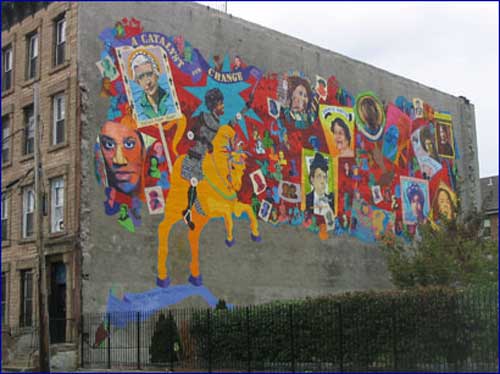- April 5, 2006
- Posted by Marc
More Responses: Wooster Roundtable #1: Public Art Funds
Recently we asked a group of people to weigh in on a single question: “IF YOU WERE GIVEN A $20 MILLION FUND TO SPEND ON PUBLIC ARTS PROGRAMS IN YOUR CITY, WHAT WOULD YOU DO WITH THE MONEY?”

Photo Courtesy of Artmaker’s Inc.
None of us would be doing this if we didn’t believe that public art can be an inspiring form of communication and expression. However, most public art (at least from what we’ve seen) fails because it divides the public from the art, creating a barrier between what is made and the people who are to view it. Also, the city bureaucracies that run most public art programs select the most non-controversial (bland, sterile, meaningless) designs, and most people end up scratching their heads and thinking art is a waste of money.
To avoid this problem we would take the $20,000,000 and form a non-profit group that would facilitate community-based art projects and programs. The more participatory and hands-on the better. Instead of throwing money at art stars, we’d help community groups and school kids fund raise (writing grants, getting donated materials) and plan projects. We’d set up an office and workspace where people can learn silk-screening and other printing techniques, a computer lab, a design shop, an outdoor graf gallery, the works. We’d focus on building permanent infrastructure for arts production and education.
A great example of how to involve people in an art project—regardless of their artistic background—is through murals. Though murals often rely on a lead muralist who lays out an image and makes it work within a given space, the process of exchange that can occur lets everyone have a voice in shaping the outcome. Everyone helps in the actual painting process. Murals also involve the community in ways that other projects, such as The Gates, simply cannot. Murals invite dialogue; they reflect what is going on in a community, its past and its future. It’s a picture of the community talking about where it’s been and where it wants to go.
If Bloomberg really wanted to address the “problem” of graffiti in a creative way, he would allocate 10% of the Vandal Task Force money to a public mural program. Philadelphia has done this with great success. Almost all murals in the city are graffiti-free. There is a certain sort of respect for murals, especially ones that involve the community. Its absurd for businesses to pay thousands of dollars to remove graffiti when a mural could just as easily be painted, and probably with a lot less money!
PS: In NYC there are already groups doing similar things, especially El Puente, Groundswell Community Mural Project, and Artmaker’s Inc, so maybe we should stop dreaming and just donate some money and time to them…
... Visual Resistance
With 20 million I would place 1000 artists in public schools (that is just about one artist for each public school in NYC). Each artist would be paid $15K (with an additional $5K for materials) for 500 hours of work and be expected to initiate and complete with students a major project. Projects could be anything like starting a samba bateria, painting a huge wall, creating a clothing line, publishing a book, etc.
This would provide money for artists while encouraging them to engage directly with a mostly underserved population. Also, a project like this would get tons of publicity – bringing attention to both arts in schools and to artists as valued member of the community.
... Mike Carreira (an art teacher in New York’s Public School systems
I would spend it on art (including photography!), music, and dance programs, facilities and, especially, innovative teachers, for youths in the poorest areas of the city. The Point, in the Bronx is an example of the kind of program and place I would fund.
... Martha Cooper
I would buy a few old apt buildings and create artist commune studio workshop joints.
Lace them up with all the fixings and have them available to public access.
20 million can buy a portion of a van gogh, or you could house and provide studio and materials to numerous
artists in a given region. Each property eventually becoming its own thing art wise after the inhabitants have renovated it.
Then place issues, like homeless shelters for one, in the hands of these artists, who
1. seem more inclined to A. care and B. help and
2. have the ideas. The creative, and usually compassionate ones amongst us here in the human zoo.
From a community projects point of view, the public art funds tend to go towards “tangible” art items. A sculpted art in a water fountain or something of this nature.
An investment in the artists (as a whole) of a community will payoff exponentially for the community, especially within
Where as a public fountain sculpture is occupying useable space.
Begging kids to climb it, Tag it, and eventually gets old and becomes a rack for xmas lights annually.
As well as an eye sore for many.
That’s the direction I’d head in
... JP
